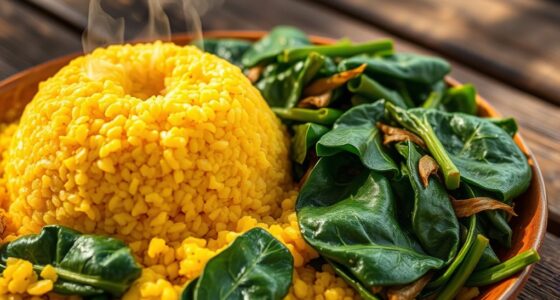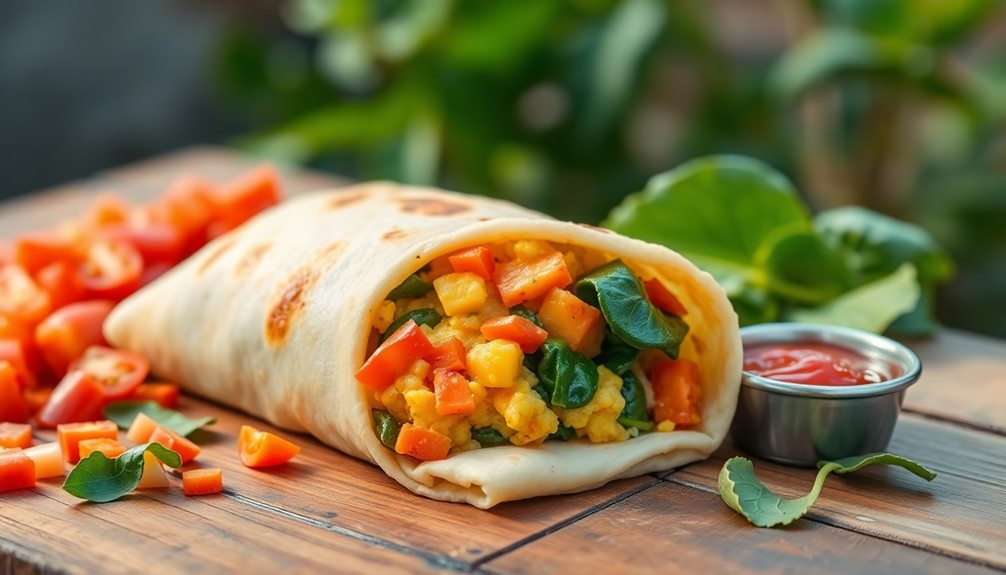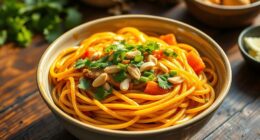Pilau is a delicious rice dish from East Africa, known for its fragrant spices like cumin, cardamom, and cloves. You'll often find it at celebrations and family gatherings, making it a symbol of togetherness! To make pilau, you start by rinsing the rice, then sauté aromatic spices in oil. Next, you add your choice of meat or vegetables and simmer the mixture with the rice until it's tender and flavorful. Finally, fluff the rice for a nice presentation, and enjoy! There's so much more to explore about this scrumptious dish and its variations, so keep going!
Key Takeaways
- Pilau is a fragrant East African rice dish, influenced by Arab, Indian, and local African cuisines, symbolizing celebration and togetherness.
- Core ingredients include rice, meat (or vegetables), aromatic spices, onions, and tomatoes, creating a rich flavor profile.
- The cooking process involves layering flavors, starting with frying spices and gradually adding meat, rice, and broth.
- Nutritionally balanced, pilau combines carbohydrates, proteins, and vegetables, with optional customization for dietary preferences.
- Regional variations exist, such as Kenya's meat-based pilau and Tanzania's coconut milk-infused version, offering diverse culinary experiences.
History
Throughout history, Pilau has woven its way through the culinary traditions of East Africa, reflecting the region's rich cultural tapestry. This delicious rice dish has roots that go back centuries, and it's influenced by many cultures, including Arab, Indian, and local African flavors. The fusion of spices like cardamom, cinnamon, and cloves creates an aromatic base that is central to Pilau’s distinctive flavor. In some variations, cooks incorporate fragrant pandan leaf in cooking, adding yet another layer of depth and sweetness to the dish. This blend of influences highlights the region’s history of trade and migration, where each culture has left its unique mark in the kitchen.
As you explore Pilau's history, you'll discover how it became popular at celebrations, family gatherings, and special occasions.
Imagine the vibrant spices that fill the air as families come together to prepare Pilau! The dish usually features fragrant spices like cumin, cardamom, and cinnamon, making it a treat for your senses.
You mightn't know, but Pilau varies from country to country. In Kenya, for example, you could find it served with meat or seafood, while in Tanzania, it's often paired with coconut milk for a unique taste!
As you dive deeper into the history of Pilau, you'll see how it's not just a meal; it's a symbol of togetherness and celebration in East African culture.
Cooking Steps
To make a delicious pilau, start by gathering your ingredients and preparing your workspace. You'll need rice, meat (like chicken or beef), spices (like cumin and cardamom), and some onions and tomatoes.
Once you have everything ready, heat some oil in a large pot over medium heat.
Next, add your chopped onions and sauté them until they're golden brown. It'll smell amazing!
Then, toss in your meat and cook until it's browned. Add the spices now, letting them sizzle for a minute to release their delicious aroma.
Now, mix in your chopped tomatoes and let them cook down a bit.
Once everything's well combined, it's time to add the rice. Stir it in and let it soak up all those wonderful flavors.
Then, pour in enough water to cover the rice, about two cups for every cup of rice. Cover the pot and let it simmer until the rice is tender, usually around 20 minutes.
Step 1. Rinse the Rice Thoroughly

Before you start cooking, rinsing the rice thoroughly is essential to ensure it's clean and free of excess starch. This step is super important because it helps make your pilau fluffy instead of sticky.
Start by measuring the amount of rice you need. Once you have that, place it in a large bowl or a fine-mesh strainer.
Now, fill the bowl or pot with cold water. Swirl the rice around gently with your fingers. You'll notice that the water becomes cloudy—that's the starch washing away! Drain the water and repeat this process several times until the water runs clear. This usually takes about three to four rinses.
Don't rush this step! Taking the time to rinse the rice properly makes a big difference in the final dish.
Once the water is clear, you can let the rice soak for about 30 minutes. This soaking helps the grains absorb some water, making them even better when you cook them.
Step 2. Add Aromatic Spices Now

Aromatic spices are the heart of a flavorful pilau, and it's time to add them to your cooking pot. Start by heating some oil in your pot over medium heat. As the oil warms up, you'll want to toss in your spices. Common choices include cumin, cardamom, and cloves. These spices will fill your kitchen with a warm, inviting aroma that makes your mouth water!
The addition of essential oils, such as peppermint for increased alertness, can enhance your cooking experience, making you more present and focused.
Next, add a few bay leaves and some cinnamon sticks for an extra layer of flavor. Stir them around for a minute or two, letting the spices release their wonderful scents. This step is crucial because it wakes up the flavors, making your pilau even more delicious.
Don't forget to add garlic and ginger! These two ingredients bring a zesty kick to your dish. Mince them up and add them to your pot. Stir everything together, letting it sizzle for just a moment longer.
You'll notice the colors brightening and the scents becoming more intense. This is your cue that you're on the right track! Now, your spices are ready to work their magic as you continue with your pilau journey. Enjoy every moment!
Step 3. Incorporate Meat or Vegetables

Now that your spices are fragrant and ready, it's time to incorporate your choice of meat or vegetables into the mix. You can pick chicken, beef, lamb, or even chickpeas and assorted veggies if you prefer a plant-based dish.
If you're using meat, cut it into bite-sized pieces, so it cooks evenly and quickly.
Add your chosen meat or veggies to the pan with those delightful spices. Stir them around for a few minutes until they start to brown a little. This step brings out amazing flavors, making your pilau even tastier!
If you're using vegetables, like carrots, peas, or bell peppers, toss them in just after the meat has browned. This way, they'll soak up all the delicious spice goodness too.
Make sure everything is well mixed, and don't forget to keep an eye on the colors and textures. You want them vibrant and appealing!
This is your chance to be creative! Experiment with different combinations and see what you like best.
Once you're happy with how everything looks, it'll be time for the next exciting step in your pilau adventure!
Step 4. Simmer Until Tender

Once you've added your meat or veggies and they're nicely browned, it's time to pour in your rice and broth. Give everything a good stir, making sure the rice is well-coated with those tasty spices.
Now, bring the mixture to a gentle boil. This is where the magic happens!
Once it starts bubbling, reduce the heat to low. Cover your pot with a snug lid to keep all that warmth and flavor locked inside. Let it simmer gently for about 20 minutes.
During this time, the rice will soak up all that delicious broth and become nice and tender. Don't forget to check on it occasionally! If it looks too dry, you can add a splash more broth or water.
As it cooks, the wonderful aroma will fill your kitchen, making everyone excited for dinner. Keep the lid on tight—this helps the steam cook the rice evenly.
When the time's up, turn off the heat and let it sit for a few minutes. This resting time helps all those flavors blend together beautifully.
Get ready for a delightful dish that's sure to impress!
Step 5. Fluff Rice With a Fork

Fluffing the rice with a fork is the final touch that transforms your pilau into a perfect side dish. After your rice has simmered and soaked up all those fragrant spices, it's time to make it light and airy.
Grab a fork, and gently insert it into the rice. You'll want to lift the grains instead of stirring them in circles. This helps keep each grain separate, making it fluffy and delightful.
Start at the edges of the pot and work your way towards the center. As you lift and gently toss the rice, you'll hear a soft, satisfying sound. It's like the rice is saying, "Yay, I'm ready!"
Keep fluffing until you've gone all around the pot. If you notice any clumps, gently break them apart with the fork.
Once you're done, step back and admire your masterpiece. The rice should look fluffy and inviting, ready to be served.
You can add a sprinkle of fresh herbs or a squeeze of lemon for extra flavor. Enjoy your pilau as a tasty side dish that will impress everyone at the table!
Final Thoughts
Pilau stands out as a vibrant culinary gem in East African cuisine, captivating palates with its rich flavors and aromatic spices. This dish isn't just a meal; it's an experience!
When you savor pilau, you're diving into the heart of a culture filled with history and warmth. Imagine sharing a big pot of this delicious rice with family and friends. You can almost hear the laughter and feel the love that goes into every bite.
Each ingredient plays a special role, from the fragrant spices to the tender meat or vegetables. It's a celebration of flavors that brings everyone together.
Making pilau can be a fun adventure, too! You get to explore different spices and try out new recipes. Whether you stick to traditional methods or add your own twist, you're bound to create something special.
Frequently Asked Questions
What Types of Rice Are Best for Making Pilau?
When making pilau, you'll want to use long-grain rice like basmati or jasmine. These types absorb flavors well and remain fluffy. Avoid short-grain rice, as it tends to become sticky and clump together.
Can Pilau Be Made Vegetarian or Vegan?
Absolutely, you can make pilau vegetarian or vegan! Just substitute meat with hearty vegetables, legumes, or tofu, and use vegetable broth for cooking. You'll still achieve that delicious, aromatic flavor you love. Enjoy experimenting!
What Are Common Side Dishes Served With Pilau?
When serving pilau, you might enjoy pairing it with refreshing salads, tangy yogurt sauces, or sautéed vegetables. These sides complement the dish's flavors and enhance your dining experience, making it even more satisfying.
How Can I Store Leftover Pilau?
To store leftover pilau, let it cool to room temperature. Transfer it to an airtight container and refrigerate. It should stay fresh for up to four days. When reheating, add a splash of water.
Is Pilau Gluten-Free?
Yes, pilau is typically gluten-free since it's made with rice, which doesn't contain gluten. Just ensure any added ingredients, like spices or broths, are also gluten-free to keep your meal safe. Enjoy!









